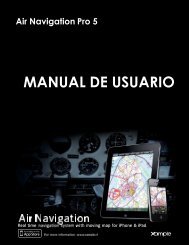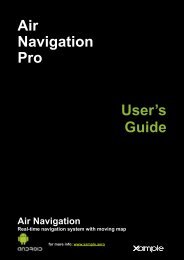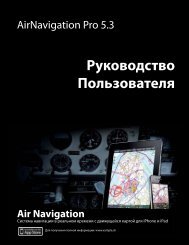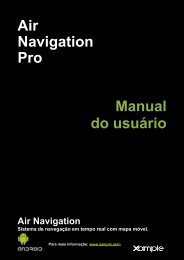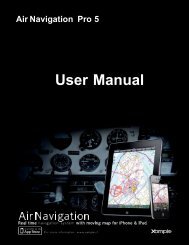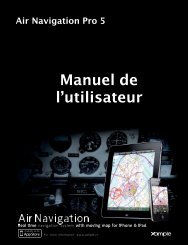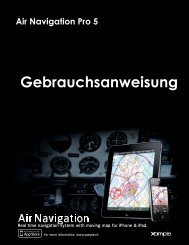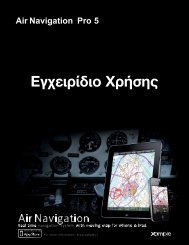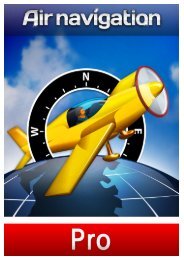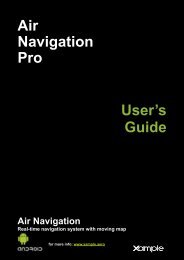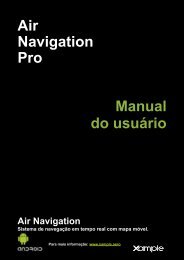Air Navigation Pro 5.2 User Manual - Xample
Air Navigation Pro 5.2 User Manual - Xample
Air Navigation Pro 5.2 User Manual - Xample
Create successful ePaper yourself
Turn your PDF publications into a flip-book with our unique Google optimized e-Paper software.
The data bar at the bottom of the moving map will display real time information such<br />
as next waypoint information (identifier, name, bearing, distance and estimated<br />
time), current speed as reported by the GPS (ground speed), track, altitude as<br />
reported by the GPS, height over ground (if the elevation data for your area is<br />
installed), quality of the GPS signal.<br />
For real time navigation, the quality of the GPS signal is required to be a green<br />
or yellow symbol. A red or orange symbol will only show an approximate location and<br />
will not report speed nor track information.<br />
For better results, you should place your device near a window, with a direct view of<br />
the sky, Do not hold the iPad with the hand covering the GPS antenna (black area on<br />
the top of the iPad). If you are flying with a full metal airplane or your airplane<br />
is equipped with anti ice windshield, the internal iPhone/iPad GPS may be a bit weak<br />
and you may need an external GPS module.<br />
Route planning<br />
By default, the moving map is in «flight mode». You can toggle the moving<br />
map from «flight mode» to «planning mode» at any time to create or<br />
amend a route by pressing the «EDIT» button in the Toolbar.<br />
To start creating a route:<br />
‣ toggle to «Edit mode», a yellow and black<br />
striped bar should appear at the top of the<br />
moving map. A search field will also appear on<br />
top of the «Route» module.<br />
‣ To add waypoints, press on waypoints of<br />
your choice on the moving map. In the<br />
waypoint popup, press the «add to route»<br />
option. A yellow star should now appear on the<br />
moving map and your waypoint should be in the<br />
«Route» list.<br />
‣ Alternatively, you can input one or more<br />
waypoint identifiers in the search field on top<br />
of the «Route» module and press return.<br />
Multiple identifiers must be separated by a<br />
space.<br />
Note: to find a waypoint near an airfield, typically<br />
VFR report points, you can use the following syntax:<br />
W@LSZG (waypoint id@airfield id) then return. This<br />
will force <strong>Air</strong> <strong>Navigation</strong> to find the closest waypoint<br />
from LSZG with the identifier W.<br />
Go back to index 21



